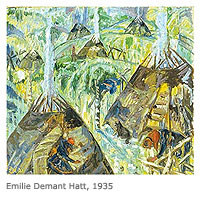 |
| Sami Working with Reindeer, 1943. Emilie Demant Hatt, Nordiska Museet |
Emilie Demant Hatt had her first art lessons with Ida Schiøtt-Jensen, a trained painter who lived on the island of Fur, across the Limfjord from Demant Hatt’s childhood home in Selde. In 1896 she moved to Copenhagen to study with the painters and feminists Emilie Mundt and Marie Luplau, and in 1898 she entered the Royal Academy of Art.[i] Two years later, frustrated by the Academy’s focus on perspective studies and plaster casts, she stopped attending classes and with her friend Christine Larsen began studying privately with Fritz Syberg. After her return in 1904 from Lapland, however, Demant Hatt decided to pursue her degree, graduating from the Academy in 1906. She painted several significant canvases at that time with a more vivid palette, using blocks of color and a flattened perspective, including “Mother in the Garden,” where her mother, solid in black, looms over waist-high blossoming apple trees in the light green orchard.
While in Sápmi [Lapland] Demant Hatt sketched and painted watercolors when she was able, but for the most part art took a back seat to ethnography until the early 1920s, when she said, she discovered Expressionism. “I had, until 1924, always painted in the old-fashioned realistic way and had looked and looked at modernist art without having understood it. Then one day, as I happened to be glancing at some modern paintings, among those some pictures by Giersing, the veil suddenly fell from my eyes and I understood, completely and forever and without any but’s, how I should paint, how I at bottom, deep in my soul, had always wanted to paint. Since then I’ve never looked back.”[ii]
Yet Demant Hatt’s artwork from around 1920 was already changing and showing the influence of modernism. In 1922 she published By the Fire [Ved ilden], a collection of Sami tales and stories, illustrating them with linoleum block prints.
In the late 1930s, when she was in her mid-sixties, Emilie Demant Hatt began once again to paint oils, many of them large, and most of them in vivid colors, of the landscape of Sápmi, based on memory and imagination. Some of these canvases belong to individuals in Sweden and Denmark. Many are held by the Nordiska Museet in Stockholm. They were given to the museum by Demant Hatt in the early 1950s, along with many of her field journals, photographs, and other papers about her research in Sápmi. One of these paintings, “Ice Bridge over River,” from 1940, is on the cover of the English translation of With the Lapps in the High Mountains.Most of Emilie Demant Hatt’s paintings can be found in two locations: the Skive Art Museum in Skive, Denmark, near where she grew up; and the Nordiska Museet in Stockholm, which owns many of her paintings of Northern Sweden and the Sami. The Nordiska has digitized the paintings it holds and other objects that she gave to the museum and they are available for viewing online at Sweden’s Digitalt Museum. http://www.digitaltmuseum.se/search?query=Emilie+Demant+Hatt&js=1
In 2014 The Nordiska Museet put on the first exhibit of Demant Hatt’s Lapland paintings in sixty years. This blog post from Lapponia tells a little about the musuem and how the paintings came to be there.
[i] Barbara Sjoholm, “What We Want: The Art of Marie Luplau and Emilie Mundt ,” Feminist Studies 35, (Fall, 2009).
[ii] Quoted in Jens Ole Lefèvre, Blade til en biografi (Skive: Skive Art Museum, 1983). The artist was Harald Giersing (1881-1927), one of Denmark’s most important 20th– century modernists.
![Emilie Demant Hatt. From the book By the Fire [Ved Ilden], lino cut. 1922.](https://emiliedemanthattdotcom.files.wordpress.com/2012/12/ved-ilden-block-prints-014.jpg?w=300&h=200)
